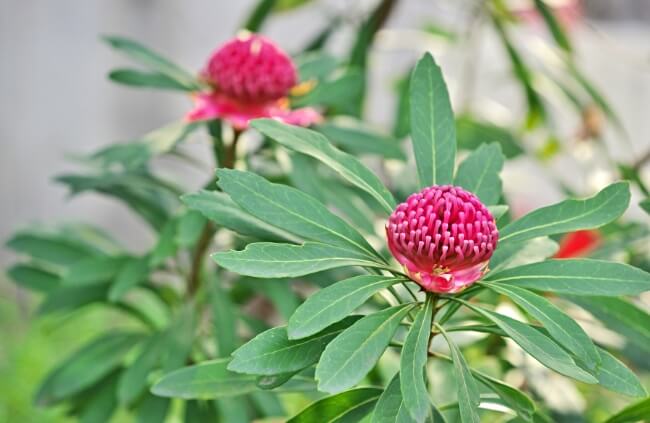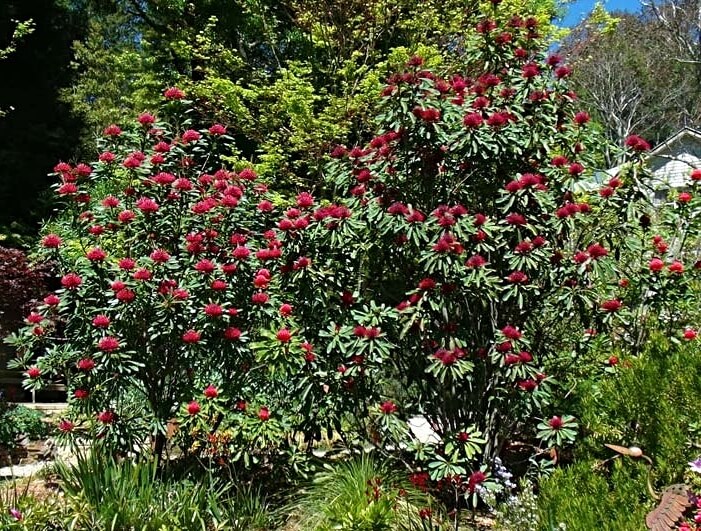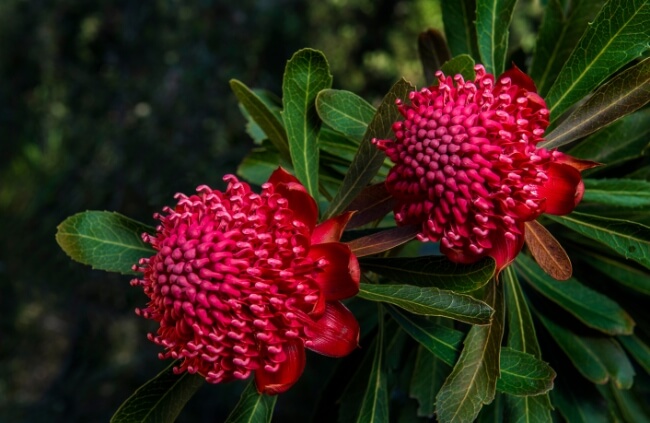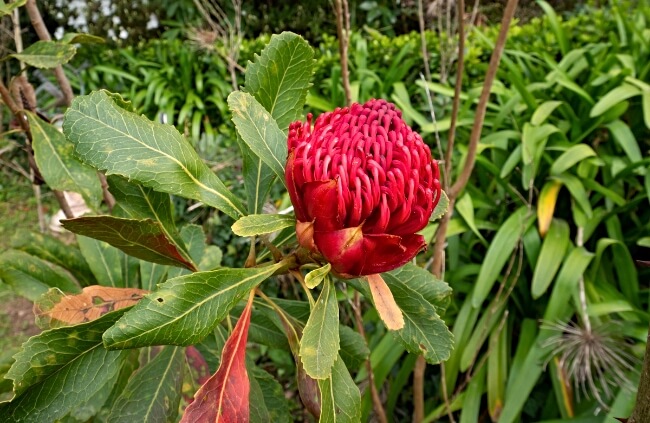One of our pickiest native plants, but one that offers exceptionally high rewards for your effort, is Telopea speciosissima. Its huge blooms are crammed with sugary nectar, and show off with vivid crimson petals that wrap into a tight globe on an elegant base of wide pointed petals, and even its seeds are good-looking.
As well as packing a visual punch, the seeds and flowers are a useful bushtucker, and as a 4m tall shrub, it offers plenty of options for planting location, as well as being quite diverse in how it is pruned. However, as we will talk about in detail, it is very, very particular when it comes to how much and how often it gets watered.
More...

Family: | Proteaceae |
|---|---|
Genus: | |
Species: | T. speciosissima |
Common names: | Australian native |
Origin: | Waratah, New South Wales Waratah |
Location: | Outdoor |
Type: | Large shrub |
Growth: | 4m tall |
Sun requirements: | Part shade |
Foliage colour: | Green |
Flower colour: | Red |
Flowering: | Early to mid-autumn |
Edible parts: | Edible flowers and seeds |
Maintenance level: | Medium-high |
Poisonous for pets: | Safe for cats and dogs |
What is Telopea speciosissima?
Telopea speciosissima, most commonly called the New South Wales Waratah, is a tall shrub, growing to about 4m, with impactful red blooms. Its leaves have tightly serrated edges and grow alternately around the stem.
Its flowers are, in fact, made up of hundreds of small florets. As they mature, each floret opens to reveal the reproductive parts, and new shoots come from the centre to flower again, leaving seed pods in a whorl around the stem.
Depending on where you live in Australia, there are other potential benefits to this plant, as it can attract brilliant wildlife to the garden, including honeyeaters, tons of important pollinators and even the eastern pygmy possum which just adore the nectar from the flowers as an important energy boost.
NSW Waratah's Natural Habitat
Telopea speciosissima, or New South Wales Waratah, is endemic to New South Wales and is so significant to the state that it is its state flower and the formal emblem of NSW.
It grows naturally in the central coast region, between Ulladulla in the south and the Watagan Mountains to the North, and typically grows beneath tree canopies as an understory shrub.
Its preferred forests are eucalyptus forests, with bright but dappled shade, where it is exposed to heavy rainfall, but in a way that is managed by rapid uptake of water from surrounding trees.
Mimicking that in your garden can be tricky, but to break it down to the most basic: part shade, and heavy, irregular watering. As a basic balance, that is about right, but it needs to be paired with the right soil conditions too.
Common Uses for NSW Waratah
The New South Wales Waratah is often used as a screening plant and can be grown together to form a hedge. It will also grow in large pots and containers to provide a statement plant on patios or balconies but will need occasional repotting or root pruning.
Its edible uses are limited to the flowers and seeds, though no part of the plant is thought to be toxic.
Its flowers can be used as decorations for salads and baking, with the accompanying nectar they provide to sweeten dishes, but are best eaten straight for the plant, or sucked to release the nectar.
The seeds are edible but with no particular benefits or flavour profile of note.
How to Grow Telopea speciosissima
These shrubs might be large but that doesn’t mean they’re sun lovers. The guide below shares details on planting propagating and pruning Telopea speciosissima, so you’ll be able to grow this incredible plant for yourself.


Get Your Free Guide:
Master Growing Australian Natives eBook
A Must Have Complete Guide for Every Australian Garden
Get Your Free Guide:
Master Growing Australian Natives eBook
A Must Have Complete Guide for Every Australian Garden

Source: GardensOnline
Best Conditions for Growing NSW Waratah
Telopea speciosissima is a famously difficult plant to grow, but if you get their conditions spot on from day one, they will prove their reputation wrong quite happily.
I’ve put together some simple DIY pointers on how to adapt your space and choose the right spot for your New South Wales Waratah.
Soil & Drainage
Drainage, or rather, water retention is the key to growing happy waratahs. They like moist soil but don’t like to be waterlogged. In nearly all gardens, that will mean adding soil improvers like manure, garden compost, or leaf mould to the soil to improve its structure before planting.
If you’re unsure about drainage rates, dig a hole square that is 30cm wide, and 30cm deep. Fill it with water and let it drain. When it's drained, fill it again. If it takes 3-12 hours to drain, it's about right. The fix is the same – add compost, manure or leaf mould and dig it through the area.
Light & Temperature
Telopea speciosissima should be grown in partial shade, either in the shadow of buildings, or larger trees. They are, despite their size, understory plants, and grow beneath the canopy of much taller trees.
In smaller gardens, they can be pruned annually to restrict their height and make it easier to manage their light requirements.
In larger gardens, try to provide shade for young plants, but don’t worry too much about mature plants, as they will cope with more direct light if grown together as a hedge. The key is to keep the roots shaded so that their soil never dries out. This is easier if the whole plant is in shade, but not impossible if it isn’t.
Note: One example position that works if you don’t have shade, is to plant them alongside a south-facing fence. This provides them with shade, and when they grow above the fence, the soil and base of the plant will still be shaded.
Shelter
One matured, NSW waratah will happily withstand high winds and coastal conditions, but they’re not frost tolerant, and they can suffer in cold winds. Protect young plants, either by planting them in amongst other shrubs or by planting them near a fence.
Planting New South Wales Waratah
We often say how important it is to water trees and shrubs well when you first plant them, but I cannot stress it enough here. When planting Telopea speciosissima, give it a full watering can of water. Completely drench the soil at its base, and then mulch over the surface.
The water should drain, but it should not be able to evaporate. Adding this same layer of mulch each year will help maintain ground moisture even on hot sunny days, but is absolutely essential when first planting.
How to Propagate Telopea speciosissima
The easiest way to propagate Telopea speciosissima is from seed, particularly if you have access to fresh seed, but it is also possible to grow these plants from cuttings, and layered cuttings.
Below, we’ll look at all three methods, but be mindful that in all cases, they can take around five years to flower after they’ve rooted and been planted into their final position. Cuttings can flower sooner, but it takes luck more than skill.

Telopea speciosissima Propagation from Seeds
Just like mature plants, Telopea speciosissima seeds germinate and develop best in part shade but with heat. Use fresh seed for the best chance of success.
Method:
- Fill individual 10cm pots with peat-free compost (don’t add any drainage).
- Sow two seeds in each pot (most will germinate, but thin them later if needed).
- Water them well.
- Place in a warm semi-shaded position.
- Stop the soil from drying out completely.
- Germination usually takes 2-3 weeks.
- A month after germination, plants should be well rooted and can be moved to bigger pots to grow on, before planting out the following year.
Propagating Telopea speciosissima from Cuttings
Taking cuttings from Telopea speciosissima can be tricky, but it's very possible. Because the leaves are so large, they dry out quickly and do not like being trimmed either. So, before you pot up your cuttings, remove all but the top two leaves, and roll the top two leaves up neatly.
Those leaves are there to provide water, not to photosynthesise. It looks weird, but it will help. Cuttings are best taken in early summer, from this year’s growth. Use stems with no flowers or flower buds, and take 15-20cm cuttings.
After dipping in rooting hormone, insert the cuttings into a well-drained compost (add perlite if you have it). We have had mixed successes rooting Waratah cuttings, so take a few per pot to boost your chances.
Propagating NSW Waratah from Layered Cuttings
The more reliable method for propagation by cuttings, and the one that seems to yield flowering plants after around two years, is propagation by layering.
There are two methods here, but the principles are the same. The one you choose will depend on the structure of the plant.
Method 1: Layering in the ground
- If your waratah has new growth near the base, bend it down to meet the soil.
- Remove leaves from a section near the end of the non-flowering stem, then strip the bark from around the nodes.
- Paint rooting hormone onto the striped section.
- Pin it to the ground, and then cover it with soil.
- It should root within a month, but can take time to send up a shoot.
Method 2: Air layering
- Find a stem with new growth and no flowering buds.
- Remove leaves from a section about 30cm from the branch tip, and strip a small section of bark near the leaf nodes.
- Paint rooting gel onto the striped section.
- Fill a plastic bag with compost, moss or coco coir, and tie it tightly around the stripped section.
- Mist inside the bag occasionally to introduce moisture.
- By the end of summer, it should have rooted, and you can remove the cutting from its parent plant, and add it to a pot of compost.
Caring for Telopea speciosissima
The key to caring for Telopea speciosissima is how and when to water it. In simple terms, just don’t let it dry out. It needs constant moisture at its roots. Depending on your soil, that can mean watering weekly, fortnightly, monthly, or not at all.
It will tell you when it needs watering though, and a simple touch check will tell you too. At the same time, you should avoid overwatering, as it doesn’t like being waterlogged, and hates boggy conditions.
Thankfully, there are some other tips to help manage moisture levels, and maintain its flowering form.
Mulching Needs
Annually mulching Telopea speciosissima will help to reduce moisture loss through evaporation during the summer months. You can use absolutely anything to do this, but organic materials that double up as fertilisers are the best.
We use our own garden compost, but any peat-free compost will do. You could also use well-rotted manure or leaf mould to add nutrients and maintain soil conditions.
A cheaper option is to use bark chips, but you may find that you need to add a general-purpose fertiliser to water once a month through summer to add nutrients.
Read our guide to find out more about the benefits of compost for mulching, and general planting.
Pruning NSW Waratah
Telopea speciosissima has a lignotuber at its base, which means you can cut it back incredibly hard and it will resprout – like coppicing eucalyptus. That is useful as a fallback and last defence against disease, and great for potted waratahs, but you can also cut back more considerately after flowering for bushier shrubs.
Always cut back to above a leaf to encourage new stems. For waratah hedges, cut back by about 30cm per year to maintain the same size and shape.
Repotting Telopea speciosissima
There is no special trick to repotting Telopea speciosissima, but it helps to cut it back slightly when moving into a new container. This just reduces strain on the plant and allows you to prune the roots too.
Remember that these shrubs want to get to 4m tall, and about the same width, so root pruning, paired with repotting every 2-3 years is important to make sure they have the space and nutrients they need in their container.
Ass fresh compost around the edge of the pot when replanting.
Common Telopea speciosissima Pests and Diseases
Telopea speciosissima is a largely trouble-free plant, other than its susceptibility to root rot and drought. In extreme moisture, it can succumb to Phytophthora cinnamomi, one of the most common root funguses.
This is difficult to resolve and will require both lifting the plant to remove black or mushy roots and letting the soil dry out completely before watering.
Aphids do sometimes cause a problem on unopened flower buds, sucking sap before flowers can open. If you notice this, pinch off those buds and discard them to stop them from spreading to other parts of the plant.
If the aphids reoccur, check for ants (it’s a weird fact, but they actually farm aphids and carry them from one plant to the next as they enjoy their sweet secretions). If you see ants around the base of your waratah, smother the main stem with Vaseline to make it harder for them to climb.
Refer to our guide on how to deal with aphids for more info.
NSW Waratah Frequently Asked Questions

How big is Telopea speciosissima?
Telopea speciosissima grows to a maximum of 4m tall but can be kept small. They usually reach 3m, in garden settings due to having higher light exposure. Each plant has a spread of 2-3m.
What is the best place to plant Telopea speciosissima?
The best place to plant Telopea speciosissima is under the canopy of other trees, or a spot that receives morning or evening light, rather than midday or afternoon sun. Aim for moisture-retentive, but reasonably well-drained soil.
Are waratahs deep-rooted?
Waratah roots will grow to about 1m deep in loose soil, but their main feeding roots are spreading, generally to about 2m on either side of the plant.
What does a waratah smell like?
Waratahs have an intensely sugary nectar, but hardly any scent. It's quite unusual in that sense, but still very worth growing for its flower form and colour.
How many species of Telopea exist?
There are five species of Telopea: T. aspera; T. mongaensis; T. oreades; T. speciosissima; T. truncata. All are native to Australia.
How long do waratahs last?
Waratahs have a short flowering season that lasts for a little over a month each year, but the plant itself can live for decades, providing a vital nectar food source for wildlife and pollinators year after year.
Adorn Your Garden with the Native Beauty of Telopea speciosissima
Telopea speciosissima is perhaps the best example of Australian plants that have a very particular habitat but can very much be worked around. Just because they are picky doesn’t mean they’re impossible to grow.
With a little bit of planning ahead, and some occasional love and attention, Telopea speciosissima will bloom with an unrivalled energy and bring your garden to life every autumn.
Published on October 6, 2023 by Lorri Hopkins
Last Updated on February 12, 2025




